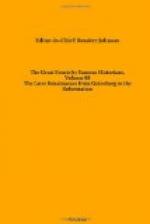Michelangelo’s sight, greatly enfeebled by this persistent work of four years, compelled him to take almost absolute repose. “The necessity he was under,” says Vasari, “during this period of work of keeping his eyes turned upward, had so weakened his sight that for several months after he could not look at a drawing nor read a letter without raising it above his head.” He enjoyed an uncontested glory in this interval of semirepose which followed his great effort. It is probable that his thoughts were now concentrated upon the sepulchral monument of his patron, the works for which he had been forced to postpone. But Leo X had other views. He was all-powerful in Florence, where, by the aid of Julius and the League of Cambray, he had reinstated his family in 1512; he now wished to endow his native city with monuments which, by recalling to the vanquished citizens of this glorious republic the magnificence of their early patrons, might help them to forget the institutions they had lost for the second time. The Church of San Lorenzo, built by Brunelleschi, where several members of his family were buried, had not been completed; he now determined to have the facade constructed. Several artists, among others San Gallo, the two Sanzovino, and Raphael, sent in plans for this important work, but Michelangelo’s was preferred, and in 1515 he went to Carrara to order the necessary marbles.
Leo did not leave him there long in quiet. Being informed that at Serrayezza, in the highest part of the mountains of Pietra Santa on the Florentine territory, there was marble equal in quality to that of Carrara, he ordered Michelangelo to go to Pietra Santa and work these quarries. In vain the latter pointed out the enormous expense of opening them, of cutting roads through the mountains, and making the marshes passable, besides the inferior quality of the marble. Leo would not listen. Michelangelo set out, made the roads, raised the marbles, remained from 1516 to 1521 in this desert, and the four years he passed there, in the full force of his age and genius, resulted in the transport of five columns, four of which remained on the seashore, and the fifth of which lies still useless and buried among the rubbish of the piazza of San Lorenzo.
Without meaning to contest the debt which the arts owe Leo X, there are certain reservations that we must make on this score. A man of letters, of amiable manners, astute, somewhat of a mischief-maker, ever fluctuating between France and the Emperor, ever on the watch to provide for his family, and, to redeem these defects, having neither heroism nor the undoubted though mistaken love that Julius II bore to Italy, his political career cannot, I think, be defended. He had the merit of being the patron of Raphael, whose facile, flexible character pleased him, and who, thanks to his protection, marked every instant of his short life by some chef d’oeuvre. It must not be forgotten that it was by the most extravagant largesses,




